High Temperature Fatigue of Aged Heavy Section Austenitic Stainless Steels
Abstract
:1. Introduction
2. Materials and Methods
3. Results
4. Discussion
5. Conclusions
Author Contributions
Funding
Conflicts of Interest
References
- Trygg, L.; Amiri, S. European perspective on absorption cooling in a combined heat and power system—A case study of energy utility and industries in Sweden. Appl. Energy 2007, 84, 1319–1337. [Google Scholar] [CrossRef]
- Yin, J.; Wu, Z. Corrosion Behavior of TP316L of Superheater in Biomass Boiler with Simulated Atmosphere and Deposit. Chin. J. Chem. Eng. 2009, 17, 849–853. [Google Scholar] [CrossRef]
- Viklund, P.; Hjörnhede, A.; Henderson, P.; Stålenheim, A.; Pettersson, R. Corrosion of superheater materials in a waste-to-energy plant. Fuel Process. Technol. 2013, 105, 106–112. [Google Scholar] [CrossRef]
- Reed, R. The Superalloys: Fundamentals and Applications; Cambridge University Press: Cambridge, UK, 2006. [Google Scholar]
- Wärner, H. High-Temperature Fatigue Behaviour of Austenitic Stainless Steel: Influence of Ageing on Thermomechanical Fatigue and Creep-Fatigue Interaction; Linköping Studies in Science and Technology; Linköping University Electronic Press: Linköping, Sweden, 2018; Volume 1824. [Google Scholar] [CrossRef]
- Wärner, H. High Temperature Fatigue Behaviour of Austenitic Stainless Steel: Microstructural Evolution during Dwell-Fatigue and Thermomechanical Fatigue. Ph.D. Thesis, Linköping Studies in Science and Technology, Linköping, Sweden, 2021. [Google Scholar] [CrossRef]
- Saidur, R.; Abdelaziz, E.; Demirbas, A.; Hossain, M.; Mekhilef, S. A review on biomass as a fuel for boilers. Renew. Sustain. Energy Rev. 2011, 15, 2262–2289. [Google Scholar] [CrossRef]
- Eurelectric. Flexible Generation: Backing up Renewables, 2011. Available online: https://www3.eurelectric.org/Download/Download.aspx?DocumentFileID=71337 (accessed on 31 October 2021).
- Christ, H.J. Effect of environment on thermomechanical fatigue life. Mater. Sci. Eng. A 2007, 468–470, 98–108. [Google Scholar] [CrossRef]
- Okrajni, J. Thermo-mechanical fatigue conditions of power plant components. J. Achiev. Mater. Manuf. Eng. 2009, 33, 53–61. [Google Scholar]
- Christ, H.J.; Jung, A.; Maier, H.J.; Teteruk, R. Thermomechanical fatigue—damage mechanisms and mechanism-based life prediction methods. Sadhana 2003, 28, 147–165. [Google Scholar] [CrossRef] [Green Version]
- Nagesha, A.; Valsan, M.; Kannan, R.; Bhanu Sankara Rao, K.; Bauer, V.; Christ, H.J.; Singh, V. Thermomechanical fatigue evaluation and life prediction of 316L(N) stainless steel. Int. J. Fatigue 2009, 31, 636–643. [Google Scholar] [CrossRef]
- Suresh Kumar, T.; Yadav, S.; Nagesha, A.; Kannan, R.; Prasad Reddy, G. Isothermal and thermomechanical fatigue behaviour of type 316LN austenitic stainless steel base metal and weld joint. Mater. Sci. Eng. A 2020, 772, 138627. [Google Scholar] [CrossRef]
- Petráš, R.; Škorík, V.; Polák, J. Thermomechanical fatigue and damage mechanisms in Sanicro 25 steel. Mater. Sci. Eng. A 2016, 650, 52–62. [Google Scholar] [CrossRef]
- Petráš, R.; Škorík, V.; Polák, J. The effect of dwell on thermomechanical fatigue in superaustenitic steel Sanicro 25. Authorea 2020, 44, 673–688. [Google Scholar] [CrossRef]
- Polák, J.; Petráš, R. Cyclic plastic response and damage mechanisms in superaustenitic steel Sanicro 25 in high temperature cycling—Effect of tensile dwells and thermomechanical cycling. Theor. Appl. Fract. Mech. 2020, 108. [Google Scholar] [CrossRef]
- Wärner, H.; Eriksson, R.; Chai, G.; Moverare, J.; Johansson, S.; Calmunger, M. Influence of ageing on thermomechanical fatigue of austenitic stainless steels. Procedia Struct. Integr. 2019, 23, 354–359. [Google Scholar] [CrossRef]
- Wärner, H.; Calmunger, M.; Chai, G.; Johansson, S.; Moverare, J. Thermomechanical fatigue behaviour of aged heat resistant austenitic alloys. Int. J. Fatigue 2019, 127, 509–521. [Google Scholar] [CrossRef]
- Hähner, P.; Affeldt, E.; Beck, T.; Klingelhöffer, H.; Loveday, M.; Rinaldi, C. Final Version of the Validated Code-of-Practice for Thermo-Mechanical Fatigue Testing; Technical Report June; European Comission, Directorate-General Joint Research Centre (DG JRC) and Institute for Energy: Petten, The Netherlands, 2006. [Google Scholar]
- Calmunger, M.; Chai, G.; Johansson, S.; Moverare, J. Deformation Behaviour in Advanced Heat Resistant Materials During Slow Strain Rate Testing at Elevated Temperature. Theor. Appl. Mech. Lett. 2014, 4, 041004. [Google Scholar] [CrossRef] [Green Version]
- Calmunger, M.; Chai, C.; Eriksson, R.; Johansson, S.; Moverare, J. Characterization of Austenitic Stainless Steels Deformed at Elevated Temperature. Metall. Mater. Trans. A 2017, 48, 4525–4538. [Google Scholar] [CrossRef]
- Heczko, M.; Polák, J.; Kruml, T. Microstructure and dislocation arrangements in Sanicro 25 steel fatigued at ambient and elevated temperatures. Mater. Scie. Eng. A 2017, 680, 168–181. [Google Scholar] [CrossRef]
- Heczko, M.; Esser, B.D.; Smith, T.M.; Beran, P.; Mazánová, V.; McComb, D.W.; Kruml, T.; Polák, J.; Mills, M.J. Atomic resolution characterization of strengthening nanoparticles in a new high-temperature-capable 43Fe-25Ni-22.5Cr austenitic stainless steel. Mater. Scie. Eng. A 2018, 719, 49–60. [Google Scholar] [CrossRef]
- Vujic, S.; Farooq, M.; Sonderegger, B.; Sandström, R.; Sommitsch, C. Numerical modelling and validation of precipitation kintecs in advanced creep resistent austenitic steel. Calphad 2012, 12, 225–232. [Google Scholar]
- Zurek, J.; Yang, S.M.; Lin, D.Y.; Hüttel, T.; Singheiser, L.; Quadakkers, W.J. Microstructural stability and oxidation behavior of Sanicro 25 during long-term steam exposure in the temperature range 600–750 °C. Mater. Corros. 2015, 66, 315–327. [Google Scholar] [CrossRef]
- Warren, A.D.; Griffiths, I.J.; Flewitt, P.E.J. Precipitation within localised chromium-enriched regions in a Type 316H austenitic stainless steel. J. Mater. Sci. 2018, 53, 6183–6197. [Google Scholar] [CrossRef] [PubMed] [Green Version]
- Guan, K.; Xu, X.; Zhang, Y.; Wang, Z. Cracks and precipitate phases in 321 stainless steel weld of flue gas pipe. Eng. Fail. Anal. 2005, 12, 623–633. [Google Scholar] [CrossRef]
- Yuin, C. Microstructure Evolution in Nb Alloyed Esshete 1250 Creep Resistant Austenitic Stainless Steel. Ph.D. Thesis, Swansea University, Swansea, UK, 2008. [Google Scholar]
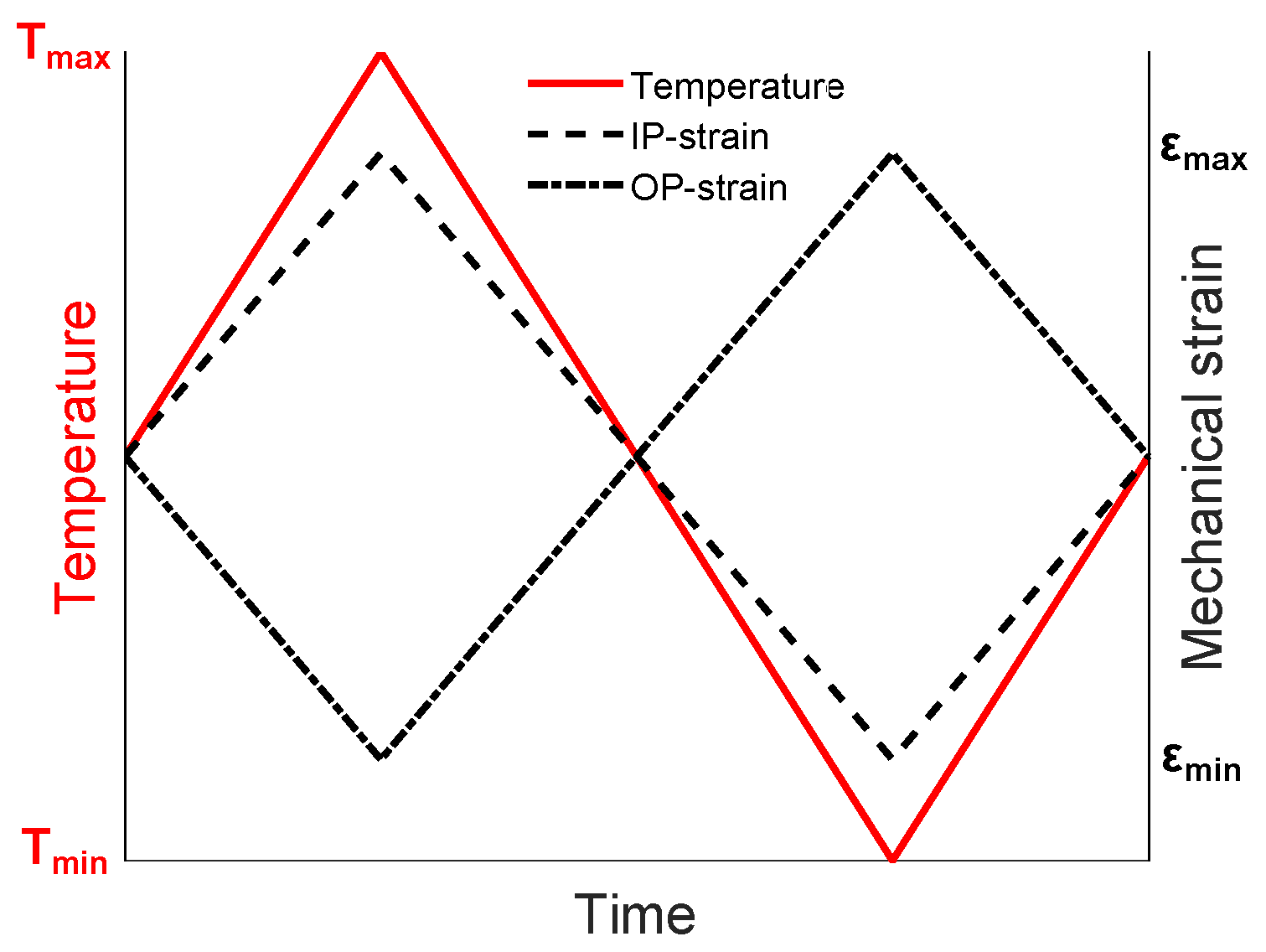
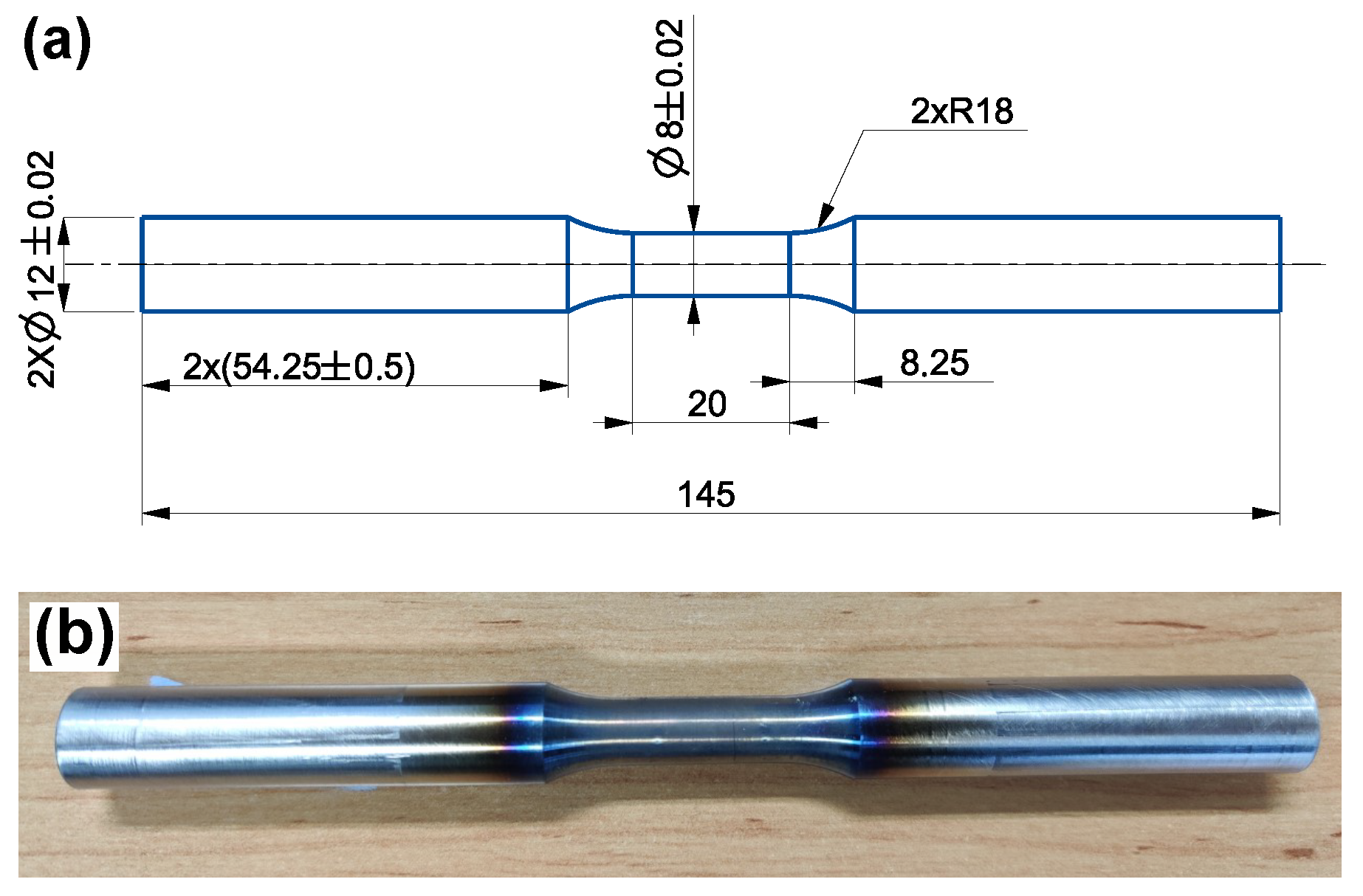
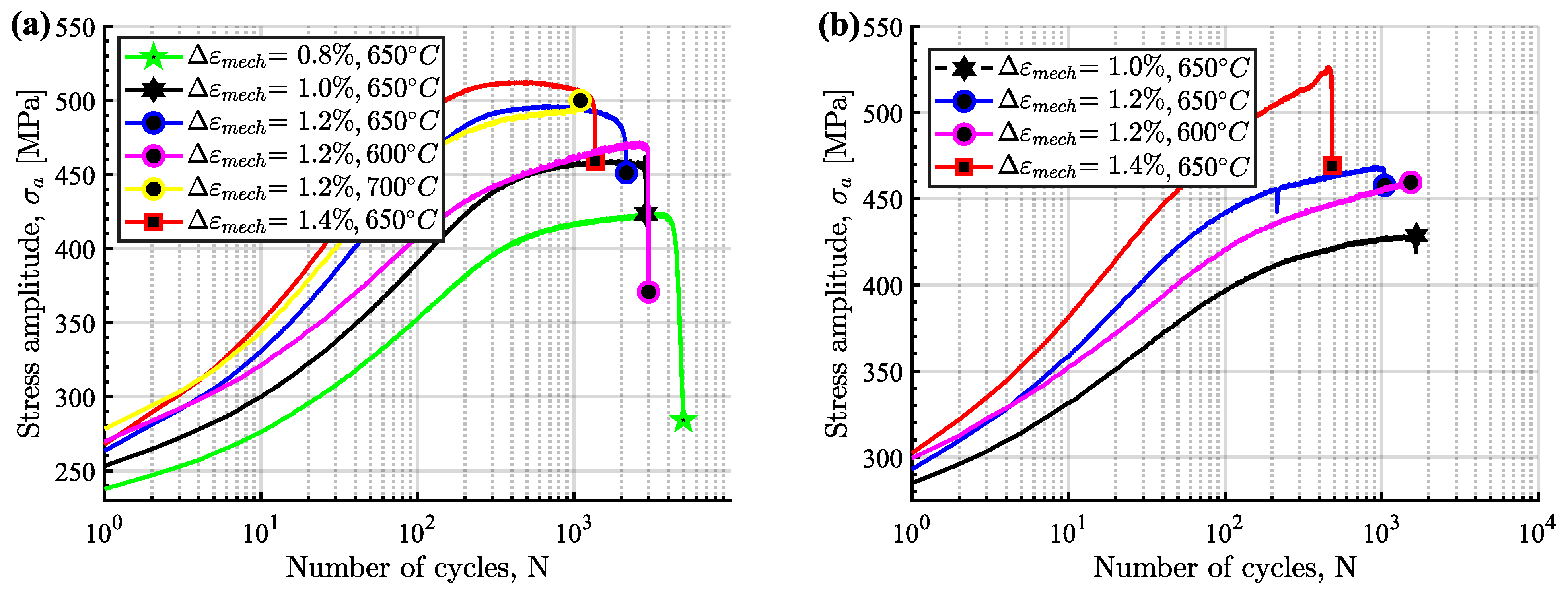
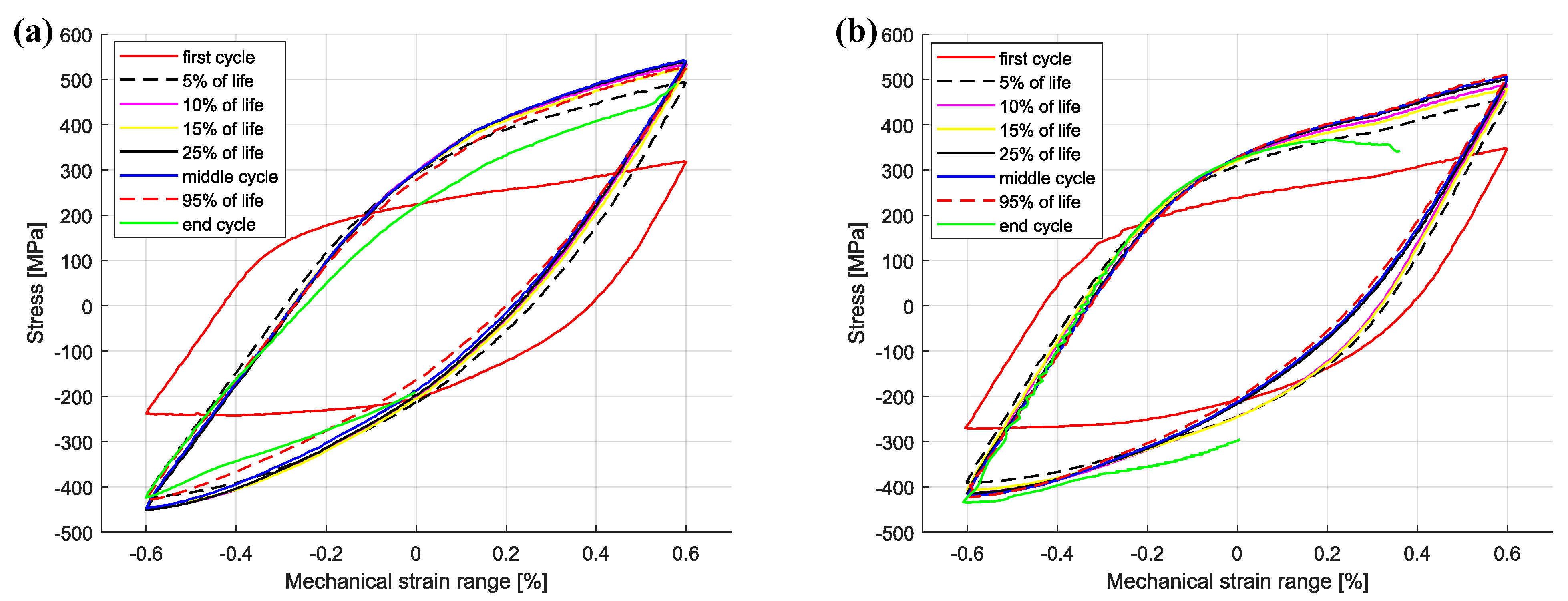
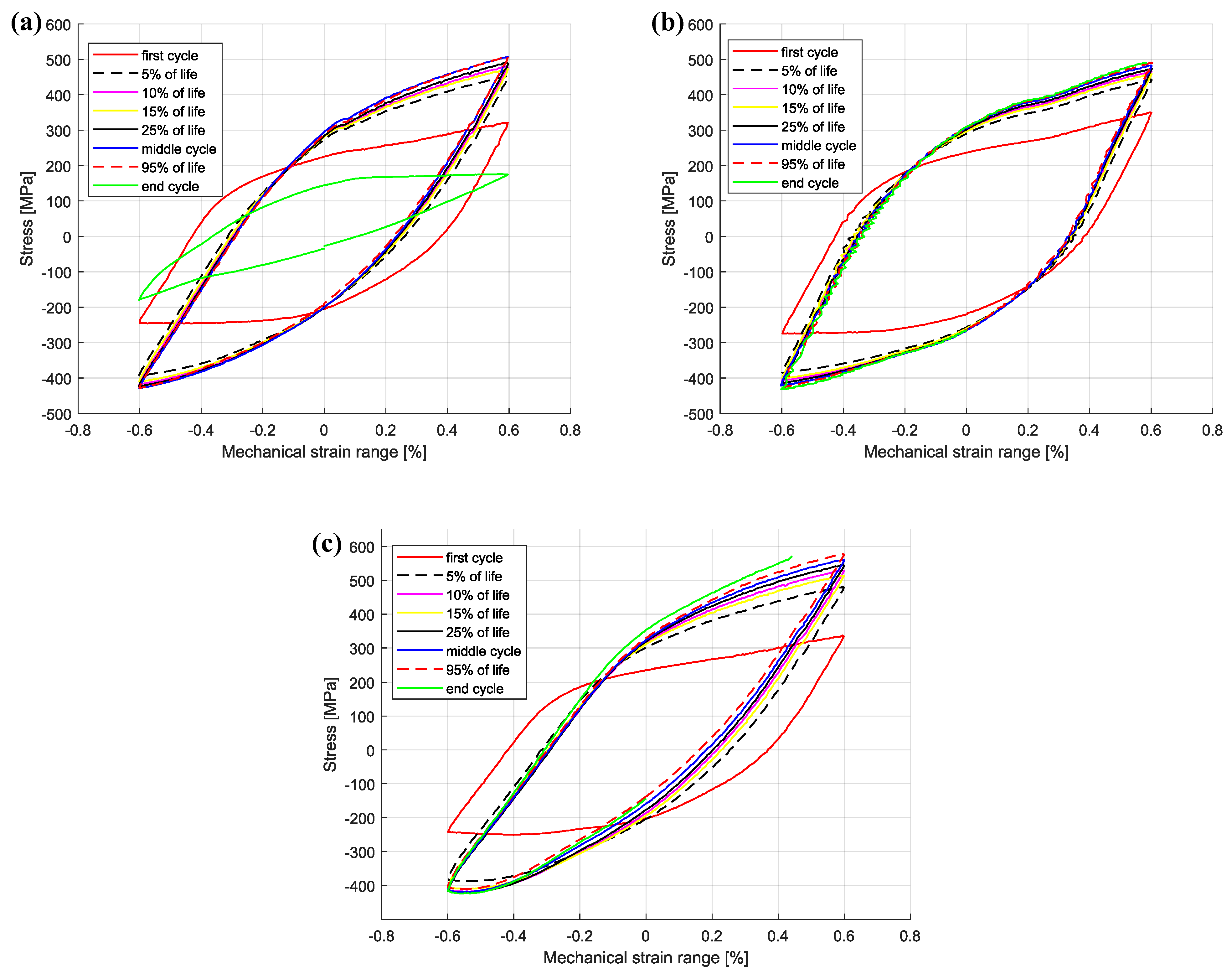
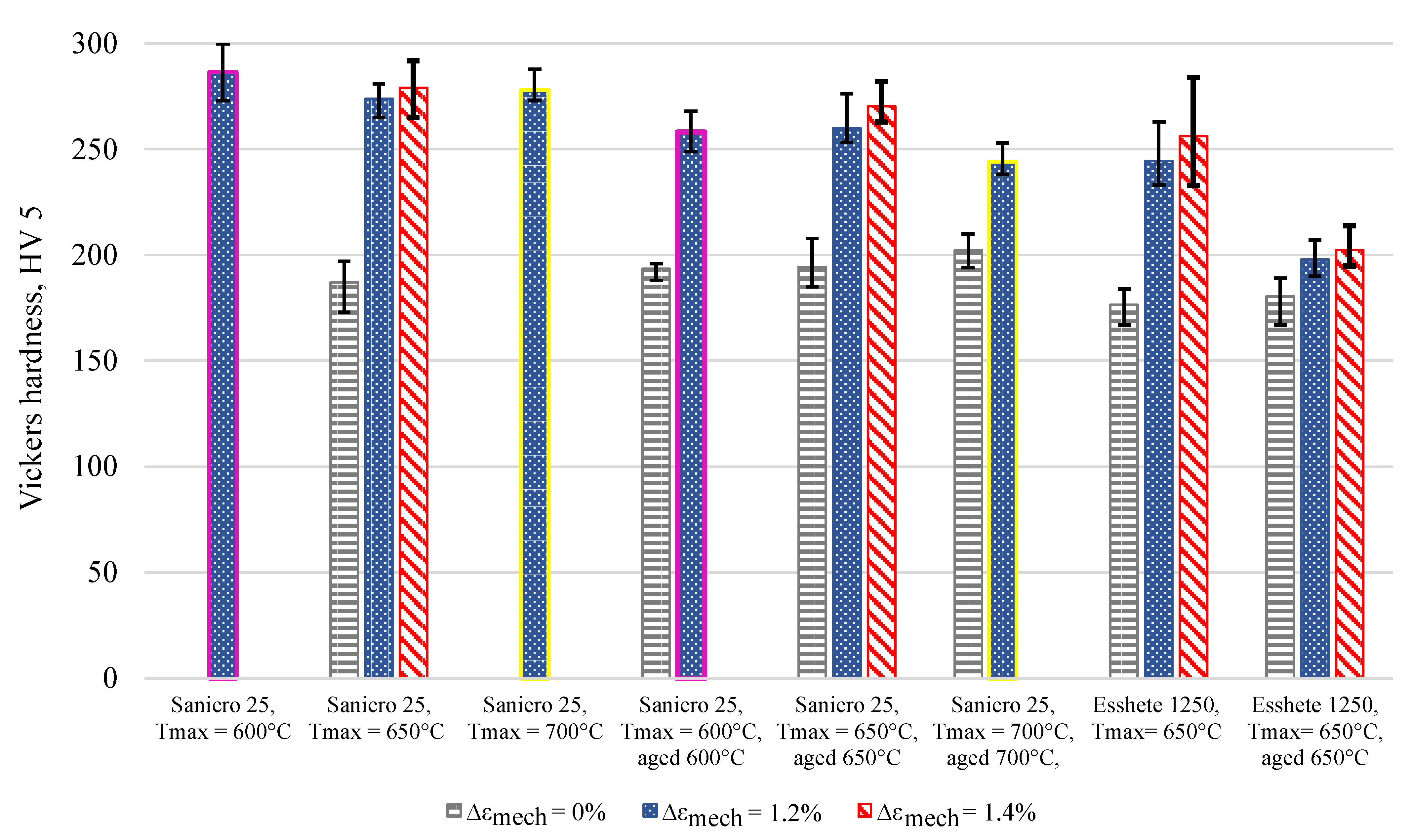
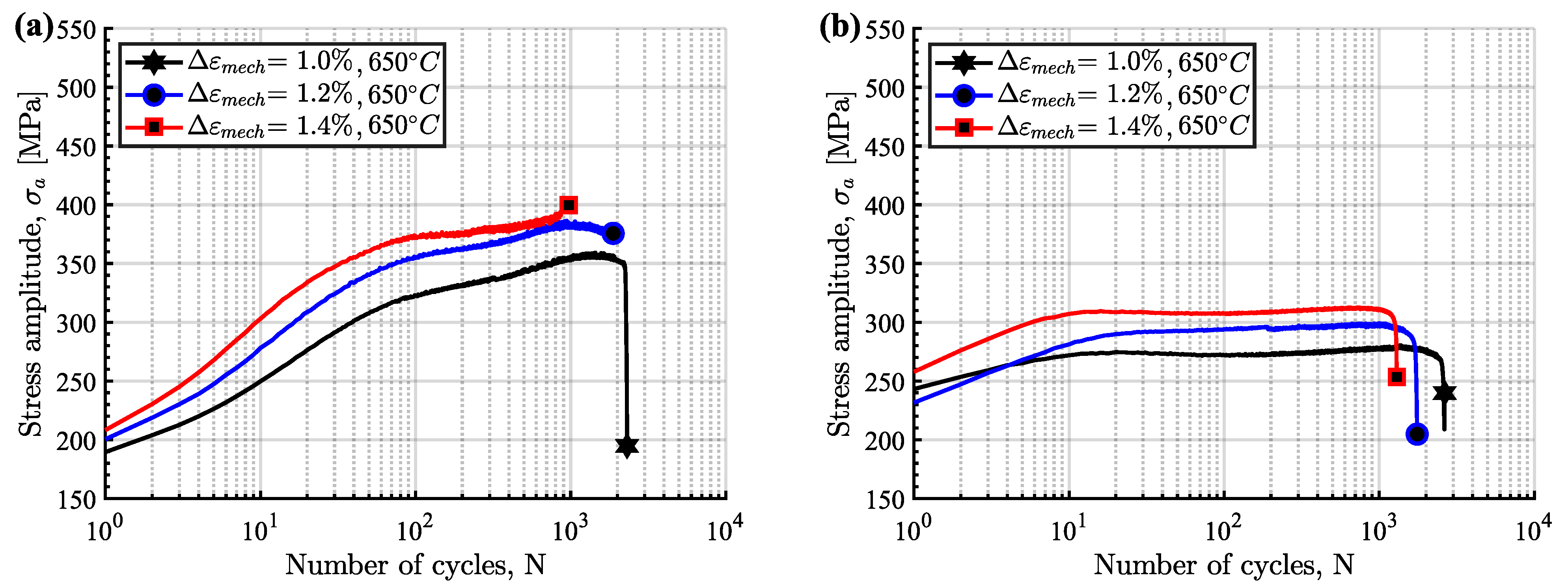
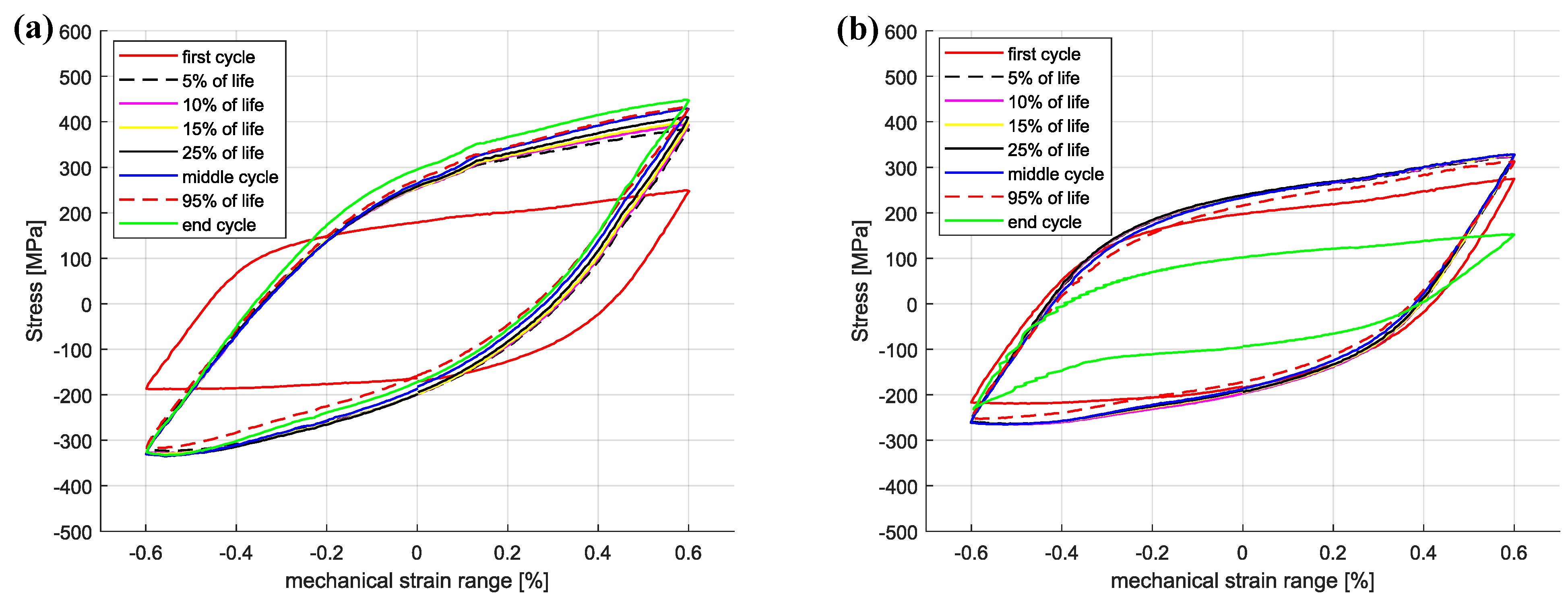
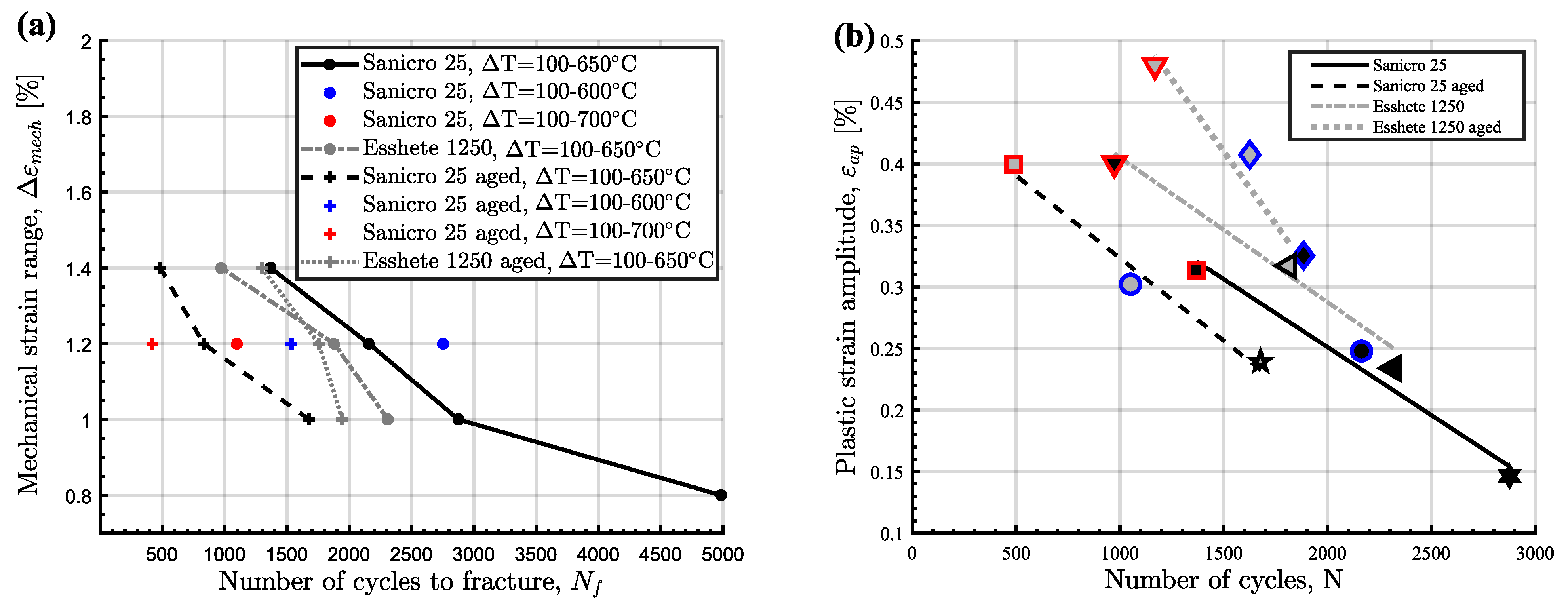

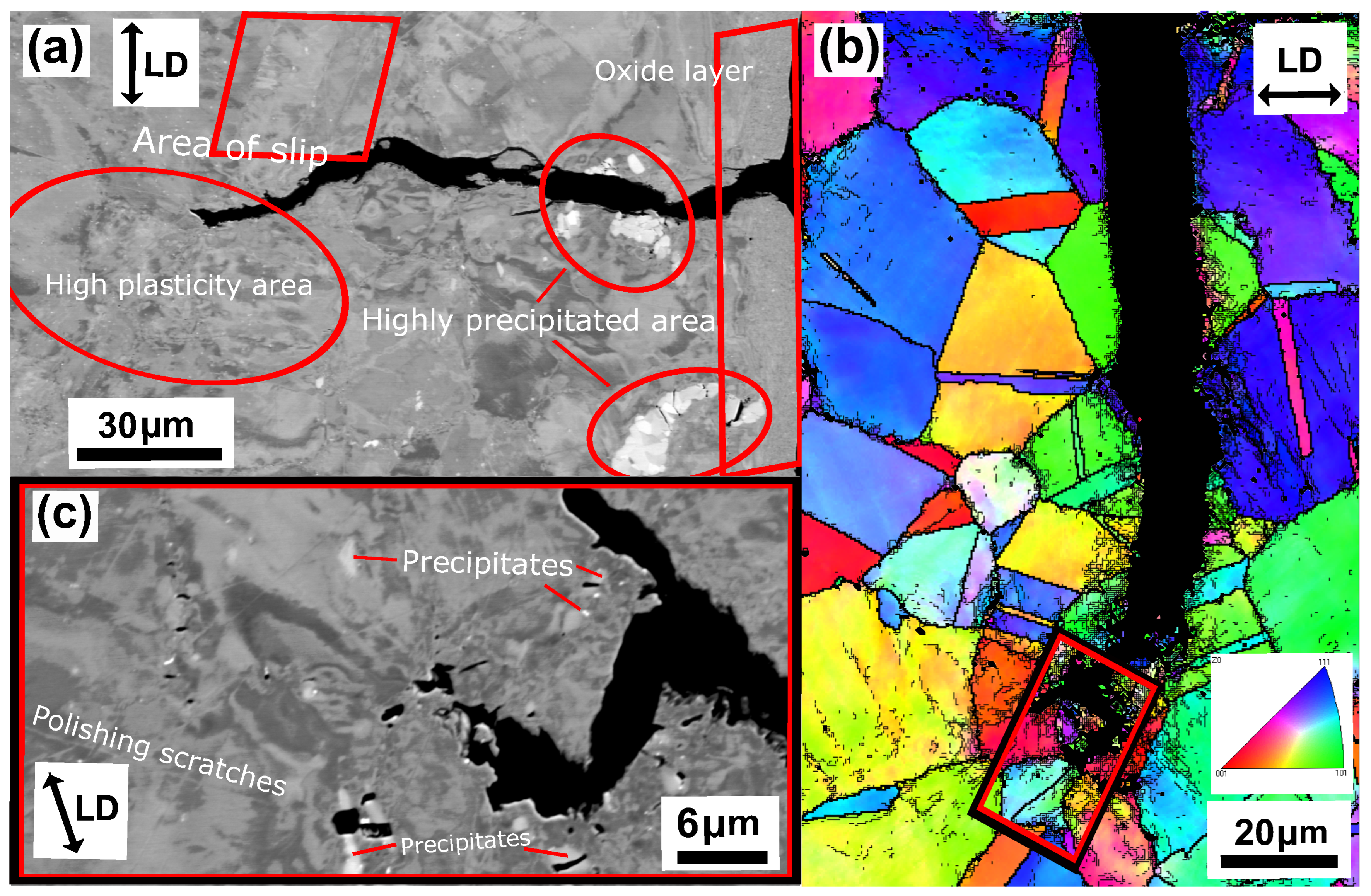
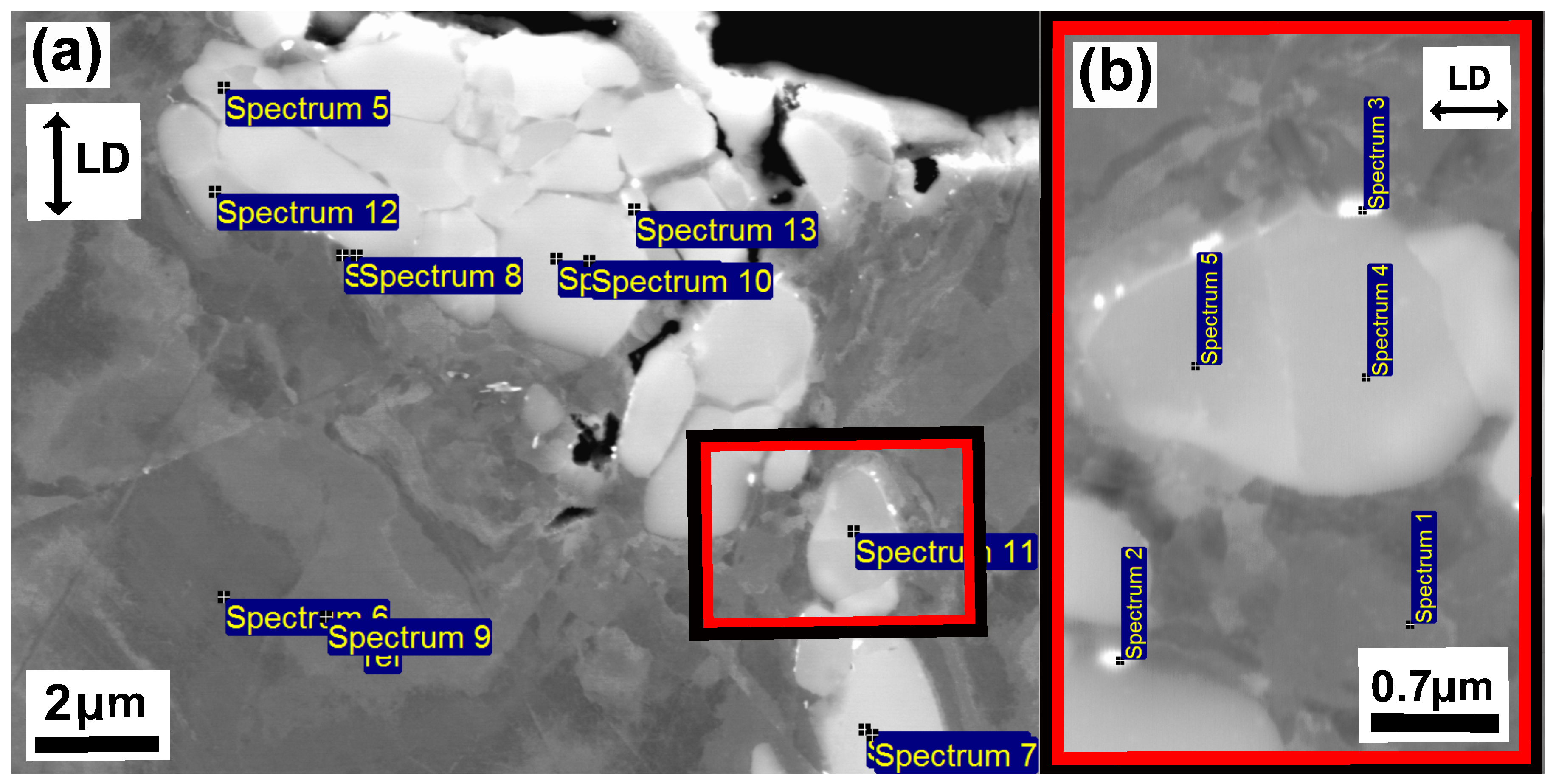

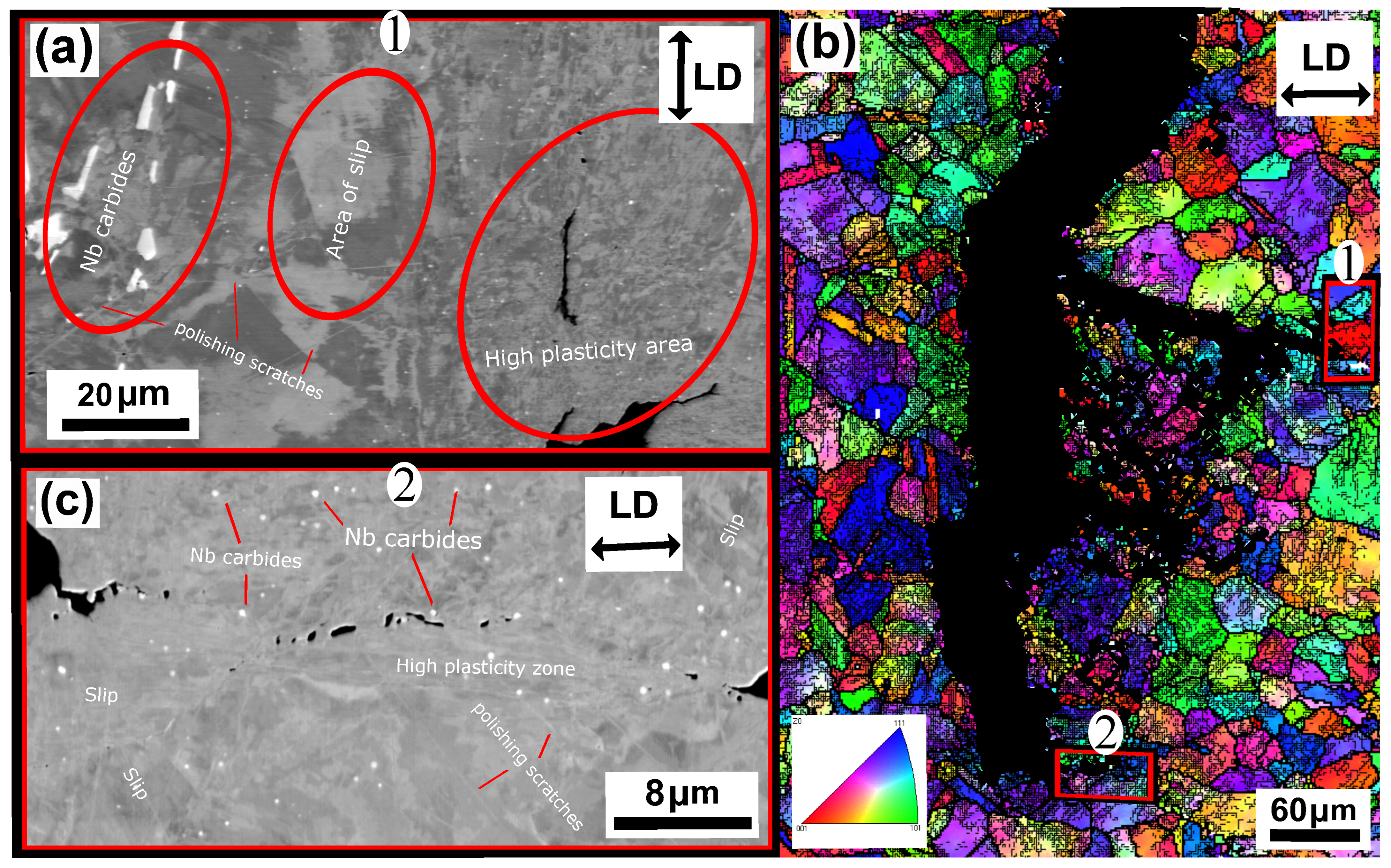
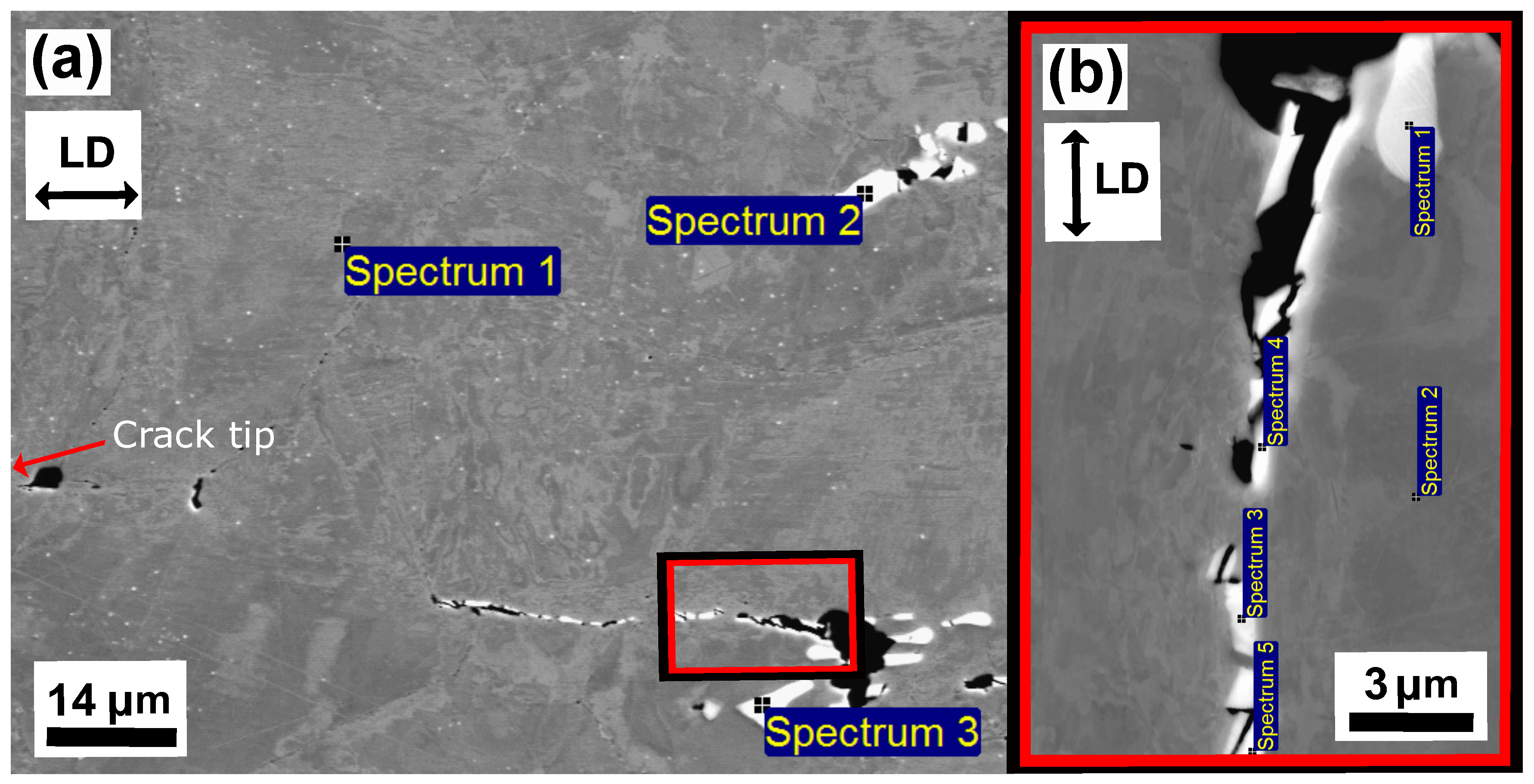
| Material | C | Cr | Ni | W | Co | Cu | Mn | Nb | N | Si | V | Mo | Fe |
|---|---|---|---|---|---|---|---|---|---|---|---|---|---|
| Sanicro 25 | 0.1 | 22.5 | 25.0 | 3.6 | 1.5 | 3.0 | 0.5 | 0.5 | 0.23 | 0.2 | - | - | Bal. |
| Esshete 1250 | 0.1 | 15 | 9.5 | - | - | - | 6.3 | 1.0 | - | 0.5 | 0.3 | 1.0 | Bal. |
| Spectrums | C | Cr | N | Ni | Cu | Nb | W |
|---|---|---|---|---|---|---|---|
| Figure 12a | |||||||
| Spectrum 5 | 6.7 | 25.7 | 4.2 | 5.2 | 0.7 | 44.5 | 3.6 |
| Spectrum 6/9 (ref) | 3.3 | 22.2 | 0.5 | 24.0 | 2.8 | 0.4 | 3.6 |
| Spectrum 7 | 5.9 | 27.0 | 3.7 | 0.6 | 0.2 | 57.5 | 4.3 |
| Spectrum 8 | 6.7 | 24.0 | 0.9 | 14.1 | 7.5 | 16.9 | 4.7 |
| Spectrum 10 | 6.9 | 26.9 | 4.4 | 1.1 | 0.2 | 56.3 | 3.8 |
| Spectrum 11 | 6.0 | 27.9 | 5.6 | 2.2 | 0.3 | 52.5 | 3.5 |
| Spectrum 12 | 5.3 | 23.3 | 1.5 | 12.3 | 1.4 | 29.0 | 4.0 |
| Spectrum 13 | 7.2 | 25.3 | 2.4 | 4.3 | 0.6 | 47.8 | 4.6 |
| Figure 12b (enlarged image) | |||||||
| Spectrum 1 (ref) | 4.7 | 20.6 | 0.4 | 23.3 | 3.5 | 0.7 | 3.2 |
| Spectrum 2 | 5.9 | 20.1 | 2.5 | 14.3 | 1.3 | 22.9 | 7.9 |
| Spectrum 3 | 7.7 | 24.1 | 2.1 | 10.0 | 1.3 | 31.6 | 5.0 |
| Spectrum 4 | 9.8 | 25.7 | 5.2 | 2.5 | 0.3 | 50.0 | 4.0 |
| Spectrum 5 | 10 | 27.9 | 4.9 | 2.9 | 0.4 | 46.9 | 2.9 |
| Spectrums | C | Cr | Mn | Fe | Ni | Nb | Mo |
|---|---|---|---|---|---|---|---|
| Figure 15a | |||||||
| Spectrum 1 (ref) | 2.9 | 15.4 | 7.2 | 61.0 | 9.8 | 0.9 | 1.4 |
| Spectrum 2 | 16.4 | 4.1 | 1.6 | 12.9 | 1.6 | 62.7 | 0.1 |
| Spectrum 3 | 6.7 | 11.1 | 4.6 | 43.6 | 6.1 | 26.3 | 0.9 |
| Figure 15b (enlarged image) | |||||||
| Spectrum 1 | 18.3 | 1.4 | 0.5 | 3.3 | 0.41 | 75.1 | 0.3 |
| Spectrum 2 (ref) | 2.8 | 15.3 | 6.7 | 63.5 | 9.2 | 0.5 | 1 |
| Spectrum 3 | 5.56 | 17.0 | 5.5 | 47.9 | 6.9 | 14.7 | 1.7 |
| Spectrum 4 | 4.21 | 13.2 | 6.1 | 58.8 | 8.3 | 7.5 | 0.9 |
| Spectrum 4 | 4.5 | 13.1 | 5.9 | 55.8 | 8.0 | 10.8 | 0.9 |
Publisher’s Note: MDPI stays neutral with regard to jurisdictional claims in published maps and institutional affiliations. |
© 2021 by the authors. Licensee MDPI, Basel, Switzerland. This article is an open access article distributed under the terms and conditions of the Creative Commons Attribution (CC BY) license (https://creativecommons.org/licenses/by/4.0/).
Share and Cite
Wärner, H.; Chai, G.; Moverare, J.; Calmunger, M. High Temperature Fatigue of Aged Heavy Section Austenitic Stainless Steels. Materials 2022, 15, 84. https://doi.org/10.3390/ma15010084
Wärner H, Chai G, Moverare J, Calmunger M. High Temperature Fatigue of Aged Heavy Section Austenitic Stainless Steels. Materials. 2022; 15(1):84. https://doi.org/10.3390/ma15010084
Chicago/Turabian StyleWärner, Hugo, Guocai Chai, Johan Moverare, and Mattias Calmunger. 2022. "High Temperature Fatigue of Aged Heavy Section Austenitic Stainless Steels" Materials 15, no. 1: 84. https://doi.org/10.3390/ma15010084
APA StyleWärner, H., Chai, G., Moverare, J., & Calmunger, M. (2022). High Temperature Fatigue of Aged Heavy Section Austenitic Stainless Steels. Materials, 15(1), 84. https://doi.org/10.3390/ma15010084







